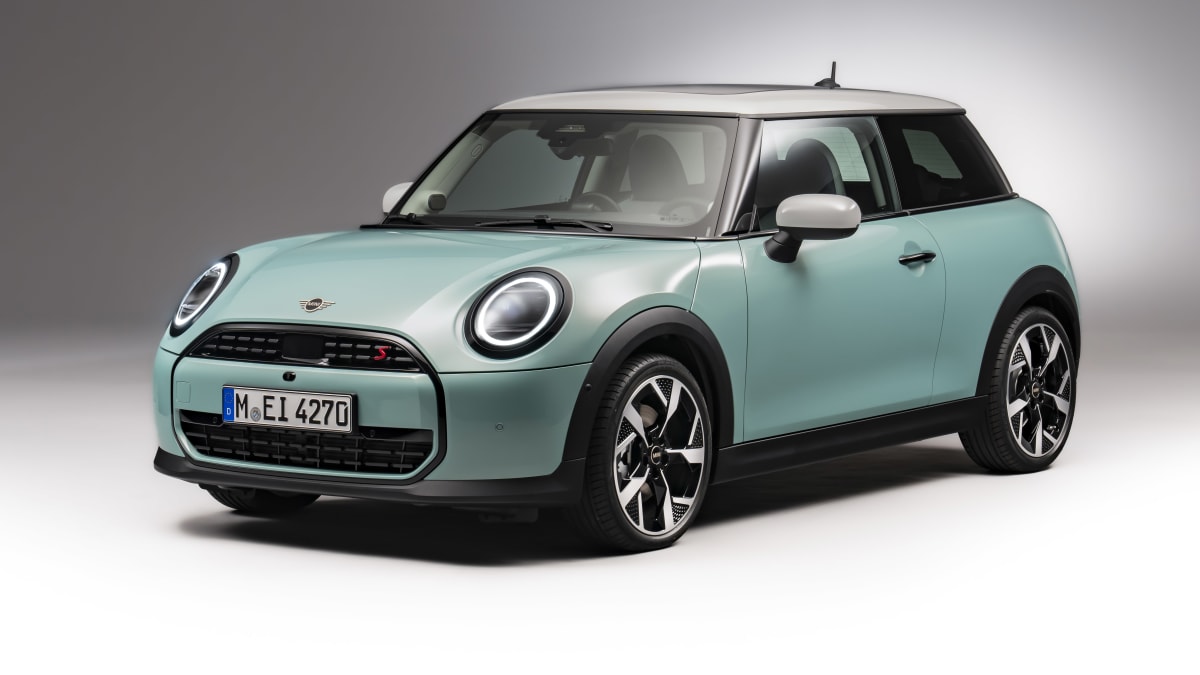The new electric Mini is a ground-up new model built in China – but the petrol version is just another facelift of a 10-year-old car. It’s due in Australia later this year.
The petrol-powered version of the new 2024 Mini Cooper three-door hatch has been unveiled, ahead of Australian showroom arrivals in the third quarter of 2024 (July to September) – alongside the Chinese-built electric model.
It is not a truly ‘new’ car, as it is yet another heavy facelift of the current Mini three-door hatch which has been on sale since 2014 – and already facelifted twice, in 2018 and 2021.
However it is more comprehensive than any facelift before it, with an all-new interior, and revised exterior styling to match the electric Cooper – which is a completely different vehicle built in China on a new electric-car platform developed with Chinese car giant Great Wall Motors (GWM).
The changes are significant enough to warrant a new internal model code – F66, rather than F56 previously – with a petrol five-door hatch and two-door convertible to follow using a similar philosophy.
Developing another heavy update – rather than an all-new car – reduces costs, and allows Mini to focus its investment on new electric cars, before the BMW-owned brand goes electric-only after 2030.
The petrol Cooper hatch – which will remain built in China – can be most easily distinguished through its door handles, which are the conventional kind used since the start of the previous model’s run in 2014, rather than the new electric Cooper’s recessed units.
It retains a clamshell bonnet – which opens around the headlights – from the previous petrol hatch, as well the black trim around the wheel arches, and the previous model’s long front overhang.
The new petrol car shares the electric Mini’s key design cues, including the front bumper design, distinctive triangular tail-lights, new wheels, and less rounded side mirrors.
The faux bonnet vent has been deleted, as have the ‘side scuttles’ on the front wheel arches, for a simpler look.
Mini has confirmed two petrol engines initially for the petrol-powered Cooper: a 115kW/230Nm 1.5-litre turbocharged three-cylinder in the Cooper C, and a 150kW/300Nm 2.0-litre turbo four-cylinder in the Cooper S.
Both are expected to be matched with seven-speed dual-clutch automatic transmissions powering the front wheels. Mini claims 0-100km/h acceleration times of 7.7 and 6.6 seconds respectively.
The manual transmission has been deleted globally, though regardless it has not been on the price list in Australia for almost two years.
Power outputs are up 15kW/10Nm and 9kW/20Nm respectively over the previous eponymous ‘Cooper’ and Cooper S. A new JCW edition is around the corner, with reports suggesting it will produce 170kW/370Nm, up from 170kW/320Nm.
Mini’s media release does not quote dimensions for the new car, however Mini specialist website MotoringFile reports the ‘F66’ Mini Cooper is 13mm longer, 18mm taller and 17mm wider, due to new bumpers, and wider wheels and tyres.
Owners can choose between three signatures for the LED daytime-running lights and tail-lights, all with unlocking and locking animations.
Inside, the petrol Cooper borrows the electric model’s minimalist look, with a 9.4-inch circular OLED touchscreen that includes most key vehicle functions, and textile material on the dashboard.
There appears to be an integrated head-up display to display the vehicle’s speed – in addition to a speed read-out on the central screen – while the car can project images and colours onto the dashboard.
The gear selector has been moved to one of the toggle switches under the infotainment screen, creating space for a dual wireless smartphone charger.
Other features include synthetic leather-look seat upholstery, a panoramic glass roof, 210 litres of boot space – expanding to 800 litres with the rear seats folded – and tech such as a Hey Mini voice-activated assistant and digital key function.
The petrol Mini has finally received a modern lane-keep assist system – rather than a lane-departure warning only – in addition to a door exit warning function.
Other available safety features include autonomous emergency braking, and adaptive cruise control. The petrol Cooper is said to have the BMW Group’s smallest-ever radar sensor, positioned in the upper section of the front grille.
Internationally the Cooper C and Cooper S will be available in Essential, Classic, Favoured and JCW trim variants – the latter an appearance package, not to be confused with the JCW hot-hatch version – with an optional three-tone contrast roof, and 16 to 18-inch alloy wheel designs.
The 2024 Mini Cooper petrol three-door hatch is due in Australia between July and September this year. Mini Australia says prices will be announced “soon”.
The current model is priced from $39,225 plus on-road costs for a Cooper Classic – the predecessor to the Cooper C – or $47,800 plus on-road costs for a Cooper S Classic.

